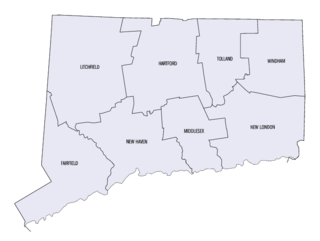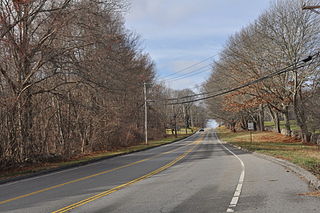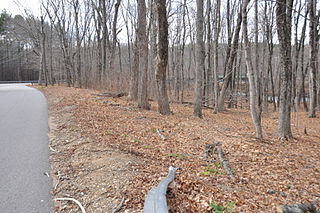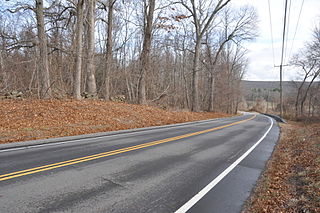
This is a list of properties and districts listed on the National Register of Historic Places in Connecticut. There are more than 1,500 listed sites in Connecticut. All 8 counties in Connecticut have listings on the National Register.
This is a list of properties on the National Register of Historic Places in the U.S. state of Vermont.

The Willimantic Footbridge is a pedestrian bridge in the Willimantic section of Windham, Connecticut. Built in 1906, it extends from Main Street southward, across Riverside Drive, railroad tracks, and the Willimantic River, connecting downtown Willimantic to the residential area south of the river. It is one of a small number of pedestrian bridges built in the early 20th century to survive in the state. It was listed on the National Register of Historic Places in 1979.

Mansfield Hollow Lake is a reservoir resting on the border of Windham County and Tolland County, Connecticut. The reservoir provides drinking water for Willimantic and helps control flooding in the 159-square-mile Thames River watershed. It was created by the Mansfield Hollow Dam and is entirely contained within Mansfield Hollow State Park and the Mansfield Hollow Wildlife Area. Designed and constructed by the United States Army Corps of Engineers, the dam substantially reduces flooding along the Quinebaug, Shetucket, and Thames rivers. Construction of the project began in 1949 with completion in 1952 at a cost of US$6.5 million. The Mansfield Hollow reservoir is located within the Shetucket River Watershed and is part of the Thames River Basin. Access to the site is available from US Route 6 and State Route 195. The damsite, covering an area of 25 acres (10 ha), was listed on the National Register of Historic Places in 2003.

The Mount Orne Bridge is a covered bridge over the Connecticut River between Lancaster, New Hampshire, and Lunenburg, Vermont. It joins Elm Street in South Lancaster with River Road in Lunenburg. Built in 1911, it is one of two Howe truss bridges across the Connecticut River. It was listed on the National Register of Historic Places in 1976.

Quinebaug Mill–Quebec Square Historic District is a historic district roughly bounded by the Quinebaug River, Quebec Square, and Elm and S. Main Streets in the town of Brooklyn in Windham County, Connecticut. The district encompasses a well-preserved 19th-century mill village. It was added to the National Register of Historic Places in 1985.

Brayton Grist Mill is an historic grist mill along Mashamoquet Brook, at the entrance to Mashamoquet Brook State Park off United States Route 44 in Pomfret, Connecticut. Built about 1890, it is one of the best-preserved 19th-century rural grist mills in the state. It was listed on the National Register of Historic Places in 1986. The mill has been restored, and is maintained by the Pomfret Historical Society as the Marcy Blacksmith Museum; it is open by appointment.

The March Route of Rochambeau's Army: Scotland Road is a historic road section in Windham, Connecticut. Extending along Scotland Road, from itsintersection with Back Rd. to 80 Scotland Road in, it is an evocative portion of the historic march route of the French Army under the Comte de Rochambeau in 1781 and 1782 during the American Revolutionary War. The troops camped beside the road within this segment in 1782. It was listed on the National Register of Historic Places in 2003.

Windham Center Historic District is a 205-acre (83 ha) area in the town of Windham, Connecticut, that is designated as a historic district. The district was listed on the National Register of Historic Places in 1979. At the time, it included 61 contributing buildings out of a total of 78 buildings, and it included 2 other contributing sites.

The Main Street Historic District encompasses the historic portion of the central business district of Willimantic, in Windham, Connecticut. The district encompasses the commercial business district of Willimantic and is roughly linear along Main Street and Riverside Drive between Church Street and Bridge Street. It was first listed on the National Register of Historic Places in 1982. Its area was increased in 1992 to include the Hall and Bill building on North Street, built in 1889 by one of Willimantic's leading printers.

Stafford Hollow, also known as Stafford, Stafford Village, or Furnace Hollow, is a village in the town of Stafford, in Tolland County, Connecticut, located at the junction of Route 19 and Route 319. Stafford Hollow was the town center of Stafford during the 18th and 19th centuries, before the growth of the village of Stafford Springs.

This is a list of National Register of Historic Places listings in New Haven, Connecticut.

The Forty-Seventh Camp of Rochambeau's Army is a historic military camp site in Windham, Connecticut. Located along Scotland Road a short way east of Windham Center, it was the site of a French Army camp in November 1782, when that army was en route from victory at Yorktown to Rhode Island. The camp site is considered of archaeological importance, because it can shed light on transient military camp sites, whose locations are not often known. It was listed on the National Register of Historic Places in 2003.

The Fourth Camp of Rochambeau's Army is a historic military camp site near Plains Road and Lovers Lane on the banks of the Shetucket River in Windham, Connecticut. It was here that the French Army under the command of Rochambeau encamped in the summer of 1781, en route from Providence, Rhode Island to the New York City area. Four divisions passed through, each one night apart, starting with the Bourbonnais on June 21, then the Royal Deux-Ponts, then the Soissonnais, and finally the Saintonge division, on successive nights. One of Rochambeau's aides described Windham at the time as "a charming market town, where, incidentally, there were many pretty women at whose homes we passed the afternoon very agreeably." Of the camp site, he wrote, "A mile away is a beautiful river with a fine wooden bridge. We camped on its banks very comfortably, though hardly militarily."

The Glen Falls Bridge is a historic bridge that formerly carried Brunswick Avenue over the Moosup River in Plainfield, Connecticut. Built in 1886 by the Berlin Iron Bridge Company, it is one of a shrinking number of surviving 19th-century lenticular truss bridges in the state. The bridge was listed on the National Register of Historic Places in 1999. It has been closed to all traffic for many years.

The William Jillson Stone House is a historic house museum at 561 Main Street inside Jillson Square Park, in the Willimantic section of Windham, Connecticut. Built in 1825-27, it is a rare local instance of a stone house, built by one of the area's early industrialists. It is now maintained by the Windham Historical Society, and was listed on the National Register of Historic Places in 1971.

March Route of Rochambeau's Army: Old Canterbury Road is a historic site in Plainfield, Connecticut along the 1781 and/or 1782 march routes of Rochambeau's army. It includes a stretch of what is now Old Canterbury Road and a stretch of Canterbury Road whose environs evoke the period of the Rochambeau army's march. It is a 2-acre (0.81 ha) site that was listed on the National Register of Historic Places in 2003.

The March Route of Rochambeau's Army: Palmer Road is a linear historic district encompassing a portion of Connecticut Route 14 in eastern Scotland, Connecticut. It was listed on the National Register of Historic Places in 2003 as an evocative surviving element of the march route of the French Army commanded by Rochambeau during the American Revolutionary War in 1781 and 1782.

The Willimantic Elks Club is a historic Elks lodge at 198 Pleasant Street in the Willimantic section of Windham, Connecticut. Built in 1925 for a lodge founded in 1914, it is one of the finest examples of Tudor Revival architecture in the region, and has been a major site of social events in the community since. The building was added to the National Register of Historic Places in 2005.





















